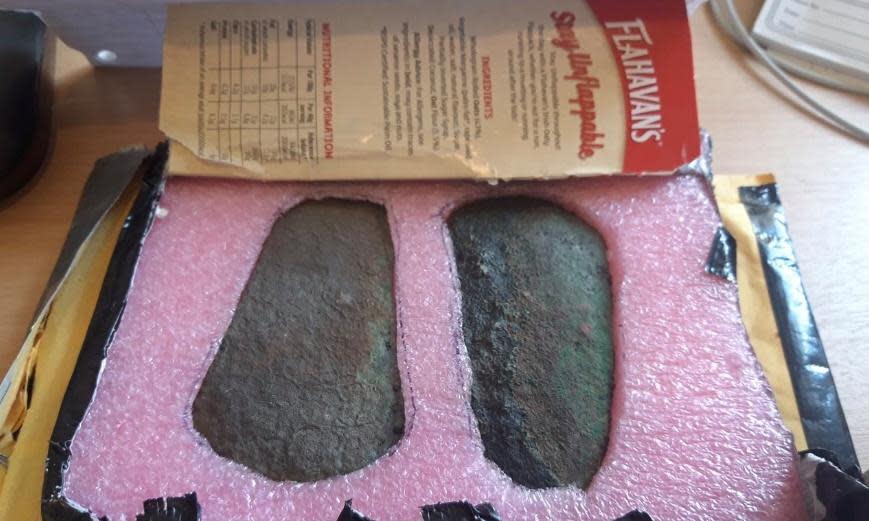Irish museum solves mystery of bronze age axe heads delivered in porridge box

When the national museum of Ireland received two 4,000-year-old axe heads, “thoughtfully” wrapped in foam inside a porridge box, from an anonymous source last month, it put out an appeal. The objects were “significant” and “exciting”, it said, but experts needed to know more about where exactly they had been found.
Now they have their answer: a farmer from County Westmeath has come forward as the mysterious sender, saying he made the “absolutely mad” discovery while using a metal detector on his land.
Thomas Dunne said he had found the items by chance on his silage field at Banagher at the end of June. “I was cutting silage [grass fodder for beef cattle] one day and a bit of metal fell off a mower,” he told the Irish Times.
He said: “We started looking for it then because we thought it might go into the silage harvester and break it up. So, I got a man with a metal detector to look for it and that’s how it was found. It was in the side of a field underneath a row of beech trees; there would have been ancient forts on the land around here.”
Related: Archaeological survey detects Roman villas and iron age farmsteads in Shropshire
It is against the law in Ireland to search for archaeological objects using a metal detector unless written permission has been given. Penalties can be up to three months in prison or a fine of up to €63,486 (£53,435). It is understood, however, that Dunne will not face charges.
When the museum received the anonymous axe heads, it issued an appeal calling for more information, saying it was “crucial to know the exact location where they were found” for “reasons that could range from ritualistic to supernatural”. Any information, it said, “would be treated in confidence and would only be used to fill out the discovery of the object”.
The museum also said it is participating in an international study of bronze age metalwork to trace the origins of the metals used in such artefacts, and that more details about the axe heads could provide critical information.
Dunne, whose family has owned the land for 40 years, said he initially thought the axe heads were the remnants of a horse shoe and had been “shocked” to discover their significance.
“I only found out about it a week after it had been in the news and I was surprised, to say the least. It’s absolutely mad when you think about it,” he told the Irish Times. The national museum, he added, were “horrid happy over this whole discovery”.
Archaeological finds in Ireland without a known owner become the property of the state and, as part of the country’s heritage, are preserved in national or designated museums for future generations.
Researchers from the national museum have now visited the site to log it in the hope of finding more information about the people who lived there 4,000 years ago.
In a statement, the national museum said it had needed to know where the axeheads had been found “as that information contributes greatly to the understanding of the object and its provenance, and therefore the value of the discovery. Distribution patterns of archaeological sites, for example, allow archaeologists to understand ancient settlements.”
The museum said it was the authority with responsibility for the care of archaeological objects, and the Irish state’s repository for all archaeological objects both from excavations and other sources.
It added: “The NMI relies on the support of the public to carry out this important function, which allows us to protect and preserve archaeological objects and our cultural heritage. The NMI also wishes to remind the public that unregulated use of detection devices causes serious damage to Ireland’s archaeological heritage.”


